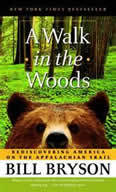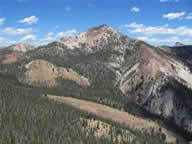"Woods are cubic. Their trees surround you, loom over you, press in from all sides. Woods choke off views and leave you muddled and without bearings. They make you feel small and confused and vulnerable, like a small child lost in a crowd of strange legs.... And they are alive.... and thus spooky."
The movie adaptation of A Walk in the Woods is on solid footing with Bill Bryson's chronicle of the struggles, discomforts, and deprivations he endured - and gratifications he derived - as he explored the Appalachian Trail in the spring and summer of 1996. The book conveys the trepidations he experienced - the perils encountered, and imagined: 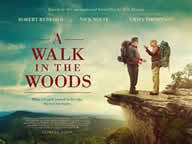
"There is something innately sinister about woods... some ineffable thing that makes you sense an atmosphere of pregnant doom with every step, and leaves you profoundly aware that you are out of your element and ought to keep your ears pricked. Though you tell yourself it's preposterous, you can't quite shake the feeling that you are being watched."
Plenty to watch for - watch out for
The "strange and palpable menace" of the woods is enlivened by lurking and stalking peril: surly rattlesnakes, water moccasins, and copperheads; bobcats, coyotes, "a tightening circle of hunger-emboldened wolves," wild boar, and onslaughts of merciless pincered fire ants.
 Oh, and the prospect of "sharing a tent for a few confused and lively moments with a sofa-sized bear."
Oh, and the prospect of "sharing a tent for a few confused and lively moments with a sofa-sized bear."
Even if hikers manage to avoid such encounters while picking their way through brambles, while negotiating hardscrabble trails that are no more than 18 inches wide, and while, acrophobically, edging along ledges that drop off to an abyss, there is poison ivy, poison sumac, and poison oak.
Even if a hiker manages to avoid cracking his head after slipping on a stream's moss-slickened rocks; even as he avoids being carried away by a river current; even as he escapes bubbling under foaming water, the weight of his pack and his water-logged boots and pants submerging him so he can't surface right-side up into forest air - there are lightning bolts.
Spending the night in the wilderness holds the chance that the ultra-wearied hiker's tent might be "crushed beneath falling trees, or by rock-falls, or eased off a precipice on ball-bearings of beaded rain and sent paragliding on to distant valley floors, or swept away by the watery wall of a flash flood."
No wonder Bill Bryson admits that "even asleep, you are a coiled spring."
A Baedeker - that recruits readers
I am so very glad that Bryson hiked great portions of the Appalachian Trail - and described his ordeals unvarnished - so that I would never (as in never ever) have to experience the discomforts and deprivations for myself.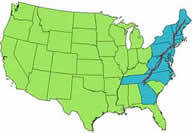
Thanks to his descriptions (and my follow-up Internet journeys to postings of panoramic photos), I have come to appreciate (vicariously, to be sure) the splendors that can be experienced by the intrepid, who also happen to be lucky.
Through Bryson's writing, the reader can appreciate the history, lore, geology, glaciation, botany, dendrology, biology, zoology, ornithology of the AT, "no ordinary footpath" - and, take it all in, while strolling along paragraphs of entertaining observations and conversations.
Most certainly, there is an allure to the reveries involving places that conjure up - well, allure: the Shenandoah region has been celebrated in no fewer than forty recordings. There are mountain monikers: Blood, Standing Indian, Old Rag, Blue Ridge, Big Butt, the Smokies. There are forests whose names alone beckon: the Chattahoochee, stands out. There are the names of "notches" - Bearpen Gap, Rockfish Gap, Elkwallow Gap, the Delaware Water Gap.
•"stroll" up Greylock and Moosilauke;
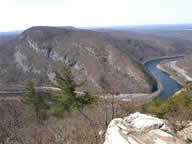 •check out Kittatinny's wall of quartzite "arrayed in long, wavery bands that lie at such an improbably canted angle - about 45 degrees - as to suggest to even the dullest imagination that something very big, geologically speaking, happened here."
•check out Kittatinny's wall of quartzite "arrayed in long, wavery bands that lie at such an improbably canted angle - about 45 degrees - as to suggest to even the dullest imagination that something very big, geologically speaking, happened here."
•thrash my way through Maine's "ominous and brooding" Hundred Mile Wilderness and its "heavy, dark, shadowy woods (inclining more to black than green)" to take in its "denim-blue lakes, and lonely undulant mountains, as far as the eye can see."
And then I would (in my imagination) take on the intimidating Mount Katahdin, beckoned by its "startling muscularity" - having negotiated the forbidding terrain of Baxter State Park, which "takes a certain hearty pride in its devotion to ruggedness and deprivation." No restaurants, no lodges... 
Happily, Bryson's A Walk in the Woods spared me trying to find my way to those scenic wonders, which are not easy "gets," by any means. The AT is not a quick turnoff from a well-lit guard-railed four-lane highway, chaperoned by restaurants and lodges.
A tour of terrain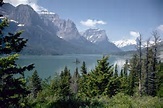 Traveling south to north, Bryson found much to laud in Shenandoah National Park, where he was taken with "a broad, ancient-seeming, deeply fetching glade cradled by steep hills." There he relished "everything you could ask for in a woodland setting... tall, stately trees broken at intervals by escalators of dusty sunshine, a winding brook, a floor of plump ferns, cool air languidly adrift in a lovely green stillness." He felt "vaguely enchanted."
Traveling south to north, Bryson found much to laud in Shenandoah National Park, where he was taken with "a broad, ancient-seeming, deeply fetching glade cradled by steep hills." There he relished "everything you could ask for in a woodland setting... tall, stately trees broken at intervals by escalators of dusty sunshine, a winding brook, a floor of plump ferns, cool air languidly adrift in a lovely green stillness." He felt "vaguely enchanted."
Bryson provided cautions - a mental foothold - regarding the Pennsylvania portion of the AT, whose terra unfirma is "where boots go to die." Boots must contend with "mile upon mile of jagged, oddly angled slabs of stone strewn about in wobbly piles.... requiring constant attentiveness if you are not to twist an ankle or sprawl on your face - not a pleasant experience with fifty pounds of momentum on your back... hikers leave limping and bruised."
In another stint, a bit further north, Bryson and his sidekick had to contend with "dense and lacerating undergrowth" that was punctuated by boulders resembling large animals momentarily at rest. All of which "lent the still recesses a certain eeriness."
In steamy, oven-like August, they trudged through "air that was oppressive and close, as if the trees and foliage were breathing on us with a hot, vegetative breath" - which imposed "an unsettling sense of isolation."
Little respite for the weary
Bryson and his sidekick found little comfort indoors. There was an "awesomely unlovely" bunkhouse whose floor was bare concrete and whose walls were made of uninsulated plywood. The place had the aura of a garage.
Even indoors, the great out-of-doors had a way of insinuating itself. After a taxing trail, they traipsed wearily into a dark and leaky woodland shelter, whose mud floor had the look and consistency of chocolate pudding. The sleeping platforms were cramped and filthy; there were scraps of wet litter everywhere. This "refuge" also sheltered the scurryings and scamperings of absolutely fearless rodents.
What the reader gets to feel
The stages of squalor and hunger are made vivid.
From "a gentle descent into squalor" there's "a self-conscious grubbiness," followed by disgust, followed by a resignation and disregard that seemed inconceivable only a few days before.
"Hunger, too, follows a defined pattern" and the hiker longs for a route to something, anything, resembling a lunch counter. He'll push himself on the chance that, over the next hill, there's a vending machine. One of his greatest fears: getting lost en route to an eatery, on "a restaurant day."
Aches and blisters are "a central feature" of any self-respecting AT hiker's existence. Bryson goes on to describe the buckling strain on the shoulders, back, lower lumbar, knees, ankles, muscles and joints. His descriptions had me reaching for a tub of analgesic rub and a carton of Ace bandages.
The weight, the cumbersomeness of carrying one's kitchen, wardrobe, and bedroom on one's back has the hiker "walk at a tilt, hunched and pressed forward, your eyes on the ground." The vividness of that description had me dialing my chiropractor, to obtain the relieving adjustment that would realign all the skeletals and soft tissue that would be tortured into spasm by simply imagining such loads and tilts.
Clearly, ever so clearly, trudging the AT with "fifty pounds of momentum" on one's back - never quite balanced and absorbing more than its share of gravity - is not a saunter, not an amble. Some walk, right.
Along with the exhaustion, there's additional exertion in fending off endless assaults of swarming mosquitoes and "a haze of repellent-resistant ravening blackflies." One may also have to flee from no-see-ums that can drive almost any hiker to distraction, and had Bryson diving into his tent.
Shelter is key. On a long stretch, hikers must somehow be prepared for plummeting temperatures as well as soaring temperatures. Bryson writes of being clammily sodden in some stretches and chilled to the bone in others. The forest air is not always bracing - sometimes it's uncomfortably refrigerated. Wind whisks away body heat.
Hypothermia
Bryson hiked through the summer of 1996, and yet this "eerily unpredictable" drop in body core temperature was a factor he noted in physiologic detail. He explained that a hiker is apt to become "desperate and irrational" in response to this "gradual and insidious sort of trauma" as his "natural responses grow sluggish and disordered." 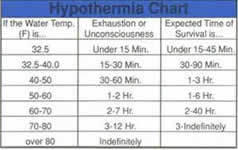
Research informed Bryson that "there is scarcely an instance of hypothermic death that isn't, in some measure, mysterious and improbable."
As a precaution, as I read on, I checked my socks to make sure they were dry; and, rather than tempt fate, I put on insulated gloves and a fleece hoodie.
Bryson explained that hypothermia and other disorienting aspects of the dense woods can rob a casual hiker of his senses. The reader is allowed to imagine "wandering to a stumbling, confounded death."
Most casual hikers, Bryson cautioned, are "emotionally and physically underequipped" to cope rationally with such circumstances and chance encounters with denizens of the wild. Given those chances, my senses and sense tell me to experience the woods via Bryson's paper product.
The rewards - "low-level ecstasy"
The reader imagines how good it feels to liberate one's toes from the lace-snugged fortresses that have absorbed miles of shadeless heat, along with the twists of ankles and jolts to the metatarsals. 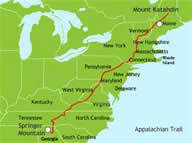
After miles and miles of nature, the reader comprehends the hiker's euphoria coming on a shelter appointed with a nearby privy, a good water source, and a picnic table.
At a hostel, even at a flea-infested motel, there's a shower that removes "coatings" from the "grubby, sweat-streaked, comprehensively-bushed" hiker, who is rank enough to assault even the nostrils of those with acute sinus congestion.
There's "the joy of stepping from the dog's breath air of a really hot summer's day into the crisp, clean, surgical chill of an air-conditioned establishment... seated in a window booth, clutching a bucket-sized Coke."
The rewards - higher levels of ecstasy
There are "flawless days" that deliver a "crisp, tangy perfection" - and the hiker gulps the "invigorating minty-clean air" of northern mountains.
There are picture-perfect views (remember those Kodak panoramas that spanned over a staircase in Grand Central Terminal?). Yes, it took an unexpectedly arduous climb and "a double eternity" to get to the summit, but Bryson lets us know the thrall was worth it. Most of the time.
There's the euphoria of descent - though even the heartiest might opt for a helicopter or a parachute rather than having to "brake" with his knees; as the "I've had enough" hiker stumbles down steep unnerving paths that portend disaster.
Bryson writes of the relief in discovering that one has not lost his bearings and way; the relief from no longer having to wonder if a helicopter could spot him through the canopy of trees.
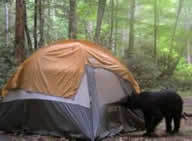 There's also the sigh of relief that the hiker has not been mugged, mauled, and "gnawed pulpy" by a bear. Lying in the inky dark, in a little tent, night after night, "with nothing but a few microns of trembling nylon between him and the chill night air, he had listened apprehensively to what he thought were grunts and mysterious snufflings, the clatter of upended cookware.... the alarming wobble of the frail tent shell as something oversized brushed against his sanctuary...." The mind had raced to recollect what might have been left out to "pique the olfactory properties of a hungry bear."
There's also the sigh of relief that the hiker has not been mugged, mauled, and "gnawed pulpy" by a bear. Lying in the inky dark, in a little tent, night after night, "with nothing but a few microns of trembling nylon between him and the chill night air, he had listened apprehensively to what he thought were grunts and mysterious snufflings, the clatter of upended cookware.... the alarming wobble of the frail tent shell as something oversized brushed against his sanctuary...." The mind had raced to recollect what might have been left out to "pique the olfactory properties of a hungry bear."
If all goes well, the gratifications - relief - outweigh the discomforts, toil, and trepidations. Hmmm.
Company and companionship, if not companionability
Bryson's sidekick was Stephen Katz, a friend from his Iowa youth. The book is dedicated to him. The newly-released film adaptation captures their companionable incompatibility along with fair servings of the book's dialogue delights. 
The Katz passages always brought a smile. I chuckled (even "threw" an occasional head-back laugh) at his wry quips, rejoinders, dismissals, and his "solutions."
To have delighted in Katz's observations and expressions, firsthand, I would have had to pack a Whole Foods lunch, bug spray, put on tick-resistant attire, and.... Just for a day, mind you. Somehow, in1996, I would have had to equip myself with an infallible GPS, a 9-G cell phone with full-forest coverage, and a propitious and thoroughly corroborated weather forecast.
Instead, I can acquire vistas and panoramas that are handsomely captured in arresting photographs in oversize books that command coffee-table prominence. And in the era of Styrofoam mega lattes and straw-and-iced-cubed coffee in plastic tumblers, coffee tables really are best used as platforms for displaying books of panoramic splendor.
Disclosures and admissions
Many decades ago, I did some hiking and trail-finding. The memories of sweltering are still with me; as are memories of shoulder-back-and-leg exhaustion; as are memories of sleeping in mud, doing the backstroke through the night to stay afloat; as are memories of unidentified sounds that pumped adrenaline in apprehension; as are memories (other times, other places) of waking up covered with snow.
Those memories surface and loom, every time my son and daughter-in-law hike into Southern California mountains; every time they camp out in Oregon woods.
As for the AT, I have Bryson's book, I have the CDs of the unabridged recorded reading engagingly-performed by Ron McLarty, and, now, the Robert Redford, Nick Nolte movie. No need for muscle rub or an asthma inhaler. Works for me.
